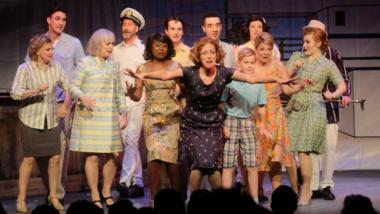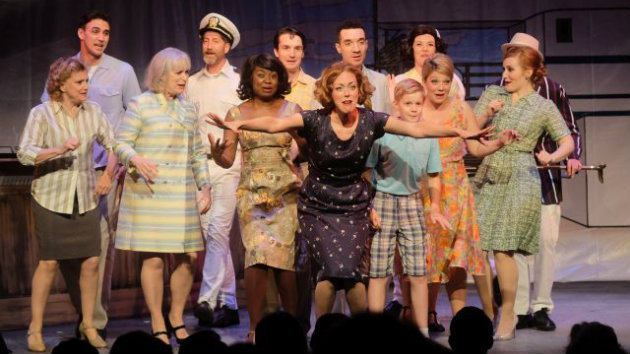
A Jolly Good Musical Cruise with Noel Coward
42nd Street Moon is opening its 2015-2016 season with Noel Coward's 1961 Sail Away, the last work for which he wrote both the book and music. (An amazing career, beginning with the 1922 musical revue, London Calling - a four-decade-long stretch of hits.) The musical is running through Nov. 15 in the Eureka Theater.
To the count of firsts and lasts, add the beginning of artistic director Greg MacKellan's last season with the company he co-founded with Stephanie Rhoads 22 years ago. Far from being a mere statistical item, MacKellan has a vital role in the success of Sail Away - giving it its first locally staged production, casting and directing it with panache. He says of the musical:
This show was Noel Coward's first production written expressly for an American audience; seeing his signature wit shine through in his modern, 1960s pop culture-inspired score is delightful. Allison F. Rich (last seen in Nick & Nora) takes on the lead role of Mimi Paragon, famously played by Elaine Stritch in the original Broadway cast, and her love interest will be played by Lucas Coleman (who starred in Its A Bird...It's A Plane...It's Superman.)
Big-voiced Rich, as the blowsy-funny-tough-vulnerable Mimi, music director/pianist Dave Dobrusky and woodwind wizard Nick Di Scala, and minimal choreographer Brittany Danielle pace the cast to bring to life a paper-thin story about hapless American tourists; they also make the most of the pleasant, only occasionally memorable music.
Rich brings down the house with "Why Do the Wrong People Travel?" at the end of the show; Coleman's seemingly limitless lungs triumph over the title song, "Go Slow, Johnny," and "Don't Turn Away from Love."
As usual - and always appreciated - at 42nd Street Moon, this is the way musical theater is meant to be... and rarely is these days. There is no amplification or supertitles, uniformly excellent diction and projection communicate flawlessly without electronic crutches.
Solos, duets, choruses, dialogs all come through clearly from everyone, even 11-year-old Jordan Martin whose major role as the pesky, spoiled brat requires both shouting and murmured comments. There is special vitality in performances from the burgeoning romance between Khalia Davis (also the production's dance captain) and Nathaniel Rothrock; company veterans Darlene Popovich and Lucinda Hitchcock Cone are having a ball. Andy Collins as Joe, the ship's purser, along with a trio of stewards, turning into street vendors in Tangiers and back again, are hilarious.
As Coward said:
When the storm clouds are riding through a winter sky
Sail away, sail away
When the love light is fading in your sweetheart's eye
Sail away, sail away
When you feel your song
Is orchestrated wrong
Why should you prolong your stay?
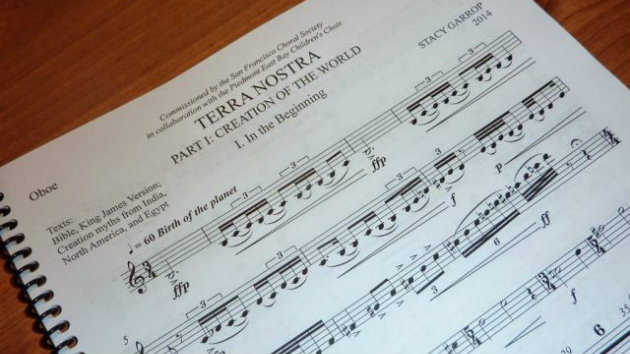
S.F. Choral Society's All-Contemporary Concerts
True to form, Robert Geary's San Francisco Choral Society next offers a pair of ambitious, contemporary concerts, including a commissioned world premiere. From the Eternal Light to Earth, the Nov. 14-15 events in the acoustically superb First Unitarian Universalist Church at Franklin and Geary, features Morten Lauridsen’s 1997 Lux Aeterna and first performances of Stacy Garrop’s Terra Nostra.
Soprano Jennifer Paulino, mezzo Betany Coffland, tenor J. Raymond Meyers, and bass-baritone Nikolas Nackley are the soloists, the Choral Society will be accompanied by the California Chamber Symphony, and the Piedmont East Bay Children’s Choir - a co-commissioner of Garrop's work - is participating.
According to Geary, who has led it for over two decades, "the Choral Society is a vibrant and innovative musical organization. In addition to a primary focus on historical literature for chorus and orchestra, the Choral Society has a vigorous program of commissioning new works," the current example being Terra Nostra.
The work about the relationship between the planet and mankind, and the quest for re-establishing a harmonious balance, is in three movements. The first and second - "Creation of the World" and "The Rise of Humanity" - have been performed as part of previous Choral Society concerts, in 2014 and earlier this year. With the addition of the third movement - "Searching for Balance" - the upcoming concerts will present the entire piece for the first time.
Garrop is a rising star among composers. In addition to serious, substantial works, she has recently premiered Bohemian Café, a lighthearted piece inspired by street musicians in Prague, performed by a woodwind quintet and double bass.
Lauridsen, former longtime composer-in-residence of the Los Angeles Master Chorale and professor of composition at USC for over 40 years, is known for wedding his passion for poetry with his music. His Lux Aeterna centers around hope and goodness throughout the world, a serene work with text derived from several Latin sources, including the Requiem Mass, Te Deum, O Nata Lux, and Veni Creator Spiritus, each referencing light.
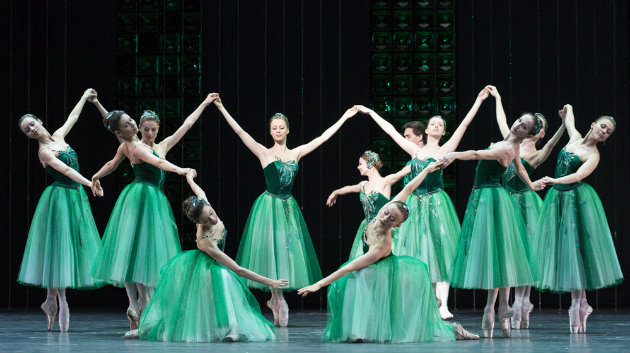
Local Movie Fare: Balanchine's Jewels from Moscow
Movie theaters in San Francisco, San Jose, Dublin, and other Bay Area locations will carry the HD telecast of the Bolshoi Ballet's recent production of George Balanchine's Jewels.
Presented by Fathom Events, BY Experience and Pathé Live, the Bolshoi performance celebrates Balanchine's three-act ballet he created for his New York City Ballet in 1967. Called the first full-length abstract ballet, Jewels has three related movements: "Emeralds," "Rubies," and "Diamonds." (San Francisco Ballet has performed it both as separate pieces and as the entire work.)
The three acts features the music of a different composer: "Emeralds" is set to the music of Gabriel Fauré, "Rubies" to the music of Igor Stravinsky, and "Diamonds" to music by Tchaikovsky. The performance stars Olga Smirnova, Semyon Chudin, Vladislav Lantratov, Anna Tikhomirova, Ekaterina Krysanova, and the Bolshoi Corps de Ballet.
The ballet, Balanchine said, has no plot or a story about jewels; the title comes from the dancers being dressed like jewels. Still, another connection is the triptych - which was inspired by Balanchine’s visit to the famous jeweler Van Cleef & Arpels on New York’s Fifth Avenue - celebrating the cities and dance schools of Paris, New York, and St. Petersburg, each bound to its own precious stone.
Of the Bolshoi joining the increasing number of companies producing the work, Alastair Macaulay wrote in The New York Times:
Audiences have long been used to the way Swan Lake and The Nutcracker become different ballets with each company. We’re at an early stage of this process with Balanchine, nowhere more so than with the quickly spreading Jewels. It’s being staged by a number of Balanchine dancers, each of whom accentuates it differently, and each company brings its own native style to his work...
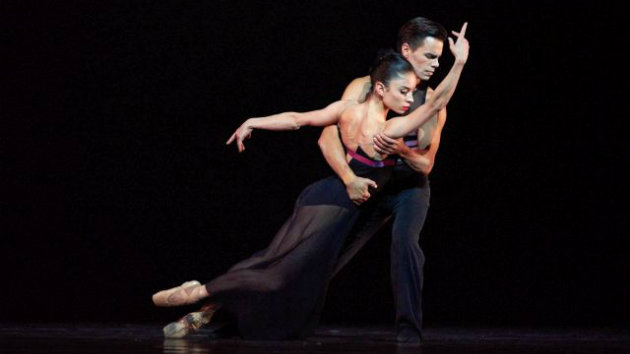
Boada and Molat to Retire from S.F. Ballet
Two acclaimed long-term principal dancers of the San Francisco Ballet are retiring at the end of the next season, the company announced on Monday.
Joan Boada and Pascal Molat, said Artistic Director Helgi Tomasson, "are two exceptional artists who have given so much to the company and our audiences over the years. I am grateful to each of them for all of their hard work and dedication and wish them the best of luck as they step into the next chapter of their lives - they will be missed.”
Boada is from Cuba, wehre he trained at the National Ballet School of Cuba before dancing with a number of companies including the National Ballet of Cuba, Le Jeune Ballet, the Australian Ballet, and Royal Ballet of Flanders. In 1999, Boada joined S.F. Ballet as a principal dancer and during his tenure, he has performed a wide range of works by choreographers including Sir Frederick Ashton, George Balanchine, John Cranko, James Kudelka, Mark Morris, Alexei Ratmansky, Jerome Robbins, Liam Scarlett, Christopher Wheeldon, Tomasson, and many others.
In addition to having a number of roles created on him, Boada has also performed principal roles in many full-length productions including Romeo in Tomasson’s Romeo & Juliet, Prince Siegfried in Tomasson’s Swan Lake, Aminta in Mark Morris’ Sylvia, and Prince Gillaume in Wheeldon’s Cinderella. In 2003, he received the Isadora Duncan Dance Award for Best Ensemble performance with Lorena Feijoo in the Tomasson/Possokhov Don Quixote.
Molat trained at the Paris Opéra Ballet School and danced with companies in his native France, including Royal Ballet of Wallonie, Royal Ballet of Flanders, and Ballets de Monte Carlo. Molat joined S.F. Ballet in 2002 as a soloist and was promoted to principal dancer a year later. During his career here, Molat has performed in ballets by George Balanchine, John Cranko, Jorma Elo, William Forsythe, Sir Kenneth MacMillan, Wayne McGregor, John Neumeier, Paul Taylor, Tomasson, and Hans van Manen.
Molat has had many roles created on him and performed principal roles in numerous full-length productions such as Mercutio in Tomasson’s Romeo & Juliet, Hilarion in Tomasson’s Giselle, the Poet in Neumeier’s The Little Mermaid, and Gremin in Cranko’s Onegin. Molat has served as a guest faculty member with S.F. Ballet School and most recently, performed the role of Mercutio in the 2015 film of Tomasson’s Romeo & Juliet, as part of the inaugural season of Lincoln Center at the Movies: Great American Dance.
After Dec. 16-31 performances of The Nutcracker, the 2016 ballet season in the War Memorial runs Jan. 24-May 8, eight programs, including three full-length story ballets: Swan Lake, Coppélia, and Onegin.
S.F. Symphony Offers Third Film Series
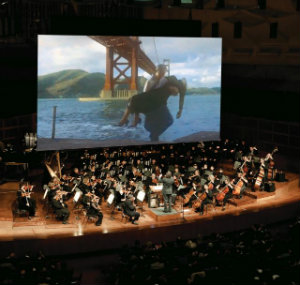
Prompted by full houses at screenings of popular films accompanied by the orchestra, San Francisco Symphony is starting the third season on Nov. 25, 27-28, with Tim Burton’s The Nightmare Before Christmas, featuring the music of Danny Elfman.
On Dec. 11-12, Justin Freer conducts the orchestra and the S.F. Symphony Chorus in newly restored music composed by Dimitri Tiomkin for Frank Capra’s holiday classic, It’s a Wonderful Life. This will mark the first participation by the chorus at a screening. Feb. 12-13 brings Alfred Hitchcock’s Vertigo back to Davies Hall, following the S.F. Symphony’s world premiere performance of the film to live accompaniment of the iconic Bernard Herrmann score in 2013.
The series concludes March 23-26 with the orchestra performing John Williams’s Academy Award-winning score to E.T. the Extra-Terrestrial.

